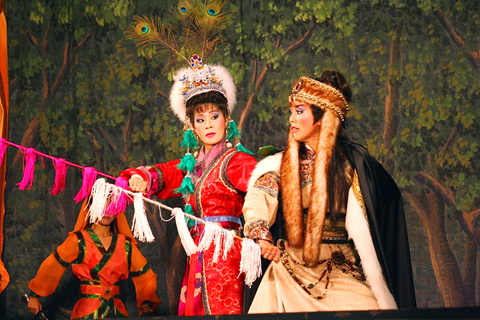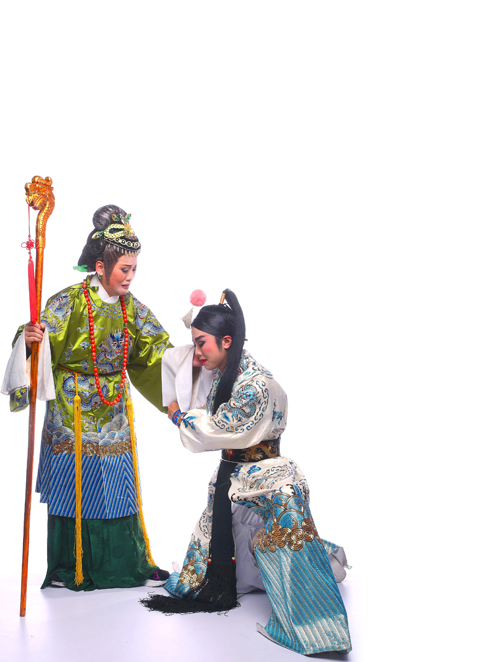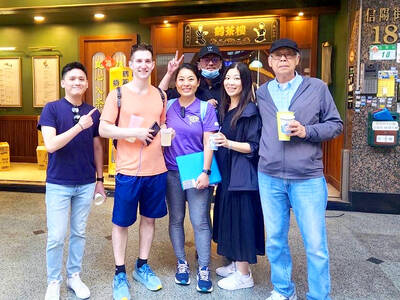Gezai opera (歌仔戲) has good claim to being the kind of opera most representative of Taiwan, and it is for this reason that the Taipei Cultural Center (台北市立社會教育館, TCC) has been working with the Taipei City Government over the last decade to hold the biennial Taiwanese Opera Collective Performances (臺北市歌子戲觀摩匯演), which will comprise a total of 13 performances starting tonight until July 20 at the Mengjia Park (艋舺公園) next to the Longshan Temple (龍山寺) in Taipei’s Wanhua District (萬華區).
This particular event started in 1999 but is actually a continuation of a long tradition going back to the 1940s when regional cultural bodies sought to select the best local opera troupes to participate in the Taiwan Regional Opera Competition (臺灣地方戲劇比賽). According to Chang Jun-tung (張俊桐), the TCC official charged with organizing this event, only Taipei now carries on the tradition as this most traditional of Taiwanese entertainments withers away.
“It’s about having the people and the money,” he said. “At least in Taipei, we can draw audiences from the neighboring areas of Taipei County, and there are a number of big temples, such as the Baoan Temple (保安宮) and the City God Temple (城隍廟), that have done much to preserve the tradition.”

PHOTO COURTESY OF FORMOSA-ZEPHYR OPERA TROUPE
Another important factor that has allowed the continuation of gezai opera is the infusion of new blood represented by groups such as the Formosa-Zephyr Opera Troupe (臺灣春風歌劇團), which is made up largely of university students and graduates with an interest in traditional arts. Troupe manager Yeh Mei-ru (葉玫汝), a former law student at the National Taiwan University (國立台灣大學), said she and her colleagues did not want to see the old traditions pass away. At the same time, Formosa-Zephyr is not at all averse to creating new-style gezai opera, such as its production of The Venetian Twins (新胡撇仔-威尼斯雙胞案), in which the group mixed a story from the Venetian playwright Carlo Goldoni with elements drawn from Japanese manga comics and local taike (台客) culture.
On this occasion, Formosa-Zephyr will be performing something a bit more traditional — Return of the Yangs’ Eighth Son (八郎探母) on Sunday — and they will be going up against 12 other troupes for cash prizes intended to help encourage development in gezai opera. “This year, we have added prizes in categories such as director and scriptwriter,” Chang said. “In the past, it was only the stars who got any attention.”
A number of gezai opera companies such as Ming Hwa Yuan (明華園戲劇團) and the Tang Mei Yun Taiwanese Opera Company (唐美雲歌仔戲團) have chosen to create sumptuous performances as a means of appealing to modern audiences. They have been so successful that they can pack out auditoriums such as the National Theater in Taipei City. Their performances cost hundreds of thousands of NT dollars to stage, and generally they only produce a couple of shows a year. “Taiwanese Opera Collective Performances is totally not like that,” said Yeh. “It is directed at the professional troupes that are still active on the temple circuit. Some of these do more than 200 shows a year.” She suggested that while the big-ticket shows had their appeal, they lacked the intimacy of an outdoor performance in which there is much more interaction between performers and the audience. “There’s more room for the purely entertaining aspects of the opera, such as the improvisational dialogue and the acrobatics,” she said. “That’s what makes opera exciting. It shouldn’t all be about telling a story.”

PHOTO COURTESY OF FORMOSA-ZEPHYR OPERA TROUPE
At the moment, Yeh said, there are two main groups in gezai opera. “Plenty of the older generation remain, but there is also a young generation, like the Xiao Fei-xia Opera Troupe (小飛霞歌劇團, performing on July 15), who want to carry on this tradition of local culture,” she said.
A competition such as the Taiwanese Opera Collective Performances gives both generations of opera performers a chance to be exposed to a wider audience, learning from each other and working toward a new style of popular art.
Although Formosa-Zephyr was formed just four years ago, some of the other troupes have a much longer history. The Yi-Sin Opera Troupe (一心歌劇團) was founded in 1989 by Sun Rung-hui (孫榮輝), the son of famous operatic performer Sun Gui (孫貴). In an interview with Sun Fu-rui (孫富叡), the troupe’s script writer and manager, he said that Yi-Sin had been created to carry on a family tradition.
“It’s lucky we have a big family,” he said. “When we needed a percussionist, we just send one of the family off to learn percussion.”
Although Yi-Sin does have performers who are not family members, Sun said that they still continue a variation on the old ways. “New performers become part of the family. They all address my dad as father,” he said. This might all be a long way from modern professional theater, but Yeh said that the flexibility of this kind of small-budget gezai opera had allowed it to survive into the modern era. There is plenty of making do, but also plenty of madcap creativity. The Formosa-Zephyr performers sometimes break into rock anthems, and Yi-Sin, in its performance on July 20, will be sporting costumes that draw inspiration from a diversity of modern sources such as manga, cosplay and Golden Ray puppet theater (金光布袋戲).
“Even within a more traditional format we are able to innovate,” Yeh said. “For instance, we have created operas from some of the famous women historical characters, and focused on issues of relationships between men and women. This makes the operas much more appealing to younger audiences.”
“Even my father’s generation is pretty open to these innovations,” Sun said. “They lived through an era of such enormous change ... they have already incorporated so many influences, from Beijing opera to folk dances and lounge acts.”
The result is, in Sun’s eyes, something uniquely Taiwanese. “I don’t think we should regard it as regional Chinese opera. I’d rather regard it as a kind of Taiwanese musical. It is our national art form.”
Performance notes:
What: Taiwanese Opera Collective Performances
(臺北市歌子戲觀摩匯演)
When: Today until July 20 (no performances between July 10 and July 15) at 7:30pm
Where: Mengjia Park (艋舺公園), off Guangzhou Street (廣州街) opposite Taipei City’s Longshan Temple (龍山寺)
Admission: Free
On the Net: www.tmseh.gov.tw

A vaccine to fight dementia? It turns out there may already be one — shots that prevent painful shingles also appear to protect aging brains. A new study found shingles vaccination cut older adults’ risk of developing dementia over the next seven years by 20 percent. The research, published Wednesday in the journal Nature, is part of growing understanding about how many factors influence brain health as we age — and what we can do about it. “It’s a very robust finding,” said lead researcher Pascal Geldsetzer of Stanford University. And “women seem to benefit more,” important as they’re at higher risk of

Eric Finkelstein is a world record junkie. The American’s Guinness World Records include the largest flag mosaic made from table tennis balls, the longest table tennis serve and eating at the most Michelin-starred restaurants in 24 hours in New York. Many would probably share the opinion of Finkelstein’s sister when talking about his records: “You’re a lunatic.” But that’s not stopping him from his next big feat, and this time he is teaming up with his wife, Taiwanese native Jackie Cheng (鄭佳祺): visit and purchase a

Experts say that the devastating earthquake in Myanmar on Friday was likely the strongest to hit the country in decades, with disaster modeling suggesting thousands could be dead. Automatic assessments from the US Geological Survey (USGS) said the shallow 7.7-magnitude quake northwest of the central Myanmar city of Sagaing triggered a red alert for shaking-related fatalities and economic losses. “High casualties and extensive damage are probable and the disaster is likely widespread,” it said, locating the epicentre near the central Myanmar city of Mandalay, home to more than a million people. Myanmar’s ruling junta said on Saturday morning that the number killed had

Mother Nature gives and Mother Nature takes away. When it comes to scenic beauty, Hualien was dealt a winning hand. But one year ago today, a 7.2-magnitude earthquake wrecked the county’s number-one tourist attraction, Taroko Gorge in Taroko National Park. Then, in the second half of last year, two typhoons inflicted further damage and disruption. Not surprisingly, for Hualien’s tourist-focused businesses, the twelve months since the earthquake have been more than dismal. Among those who experienced a precipitous drop in customer count are Sofia Chiu (邱心怡) and Monica Lin (林宸伶), co-founders of Karenko Kitchen, which they describe as a space where they